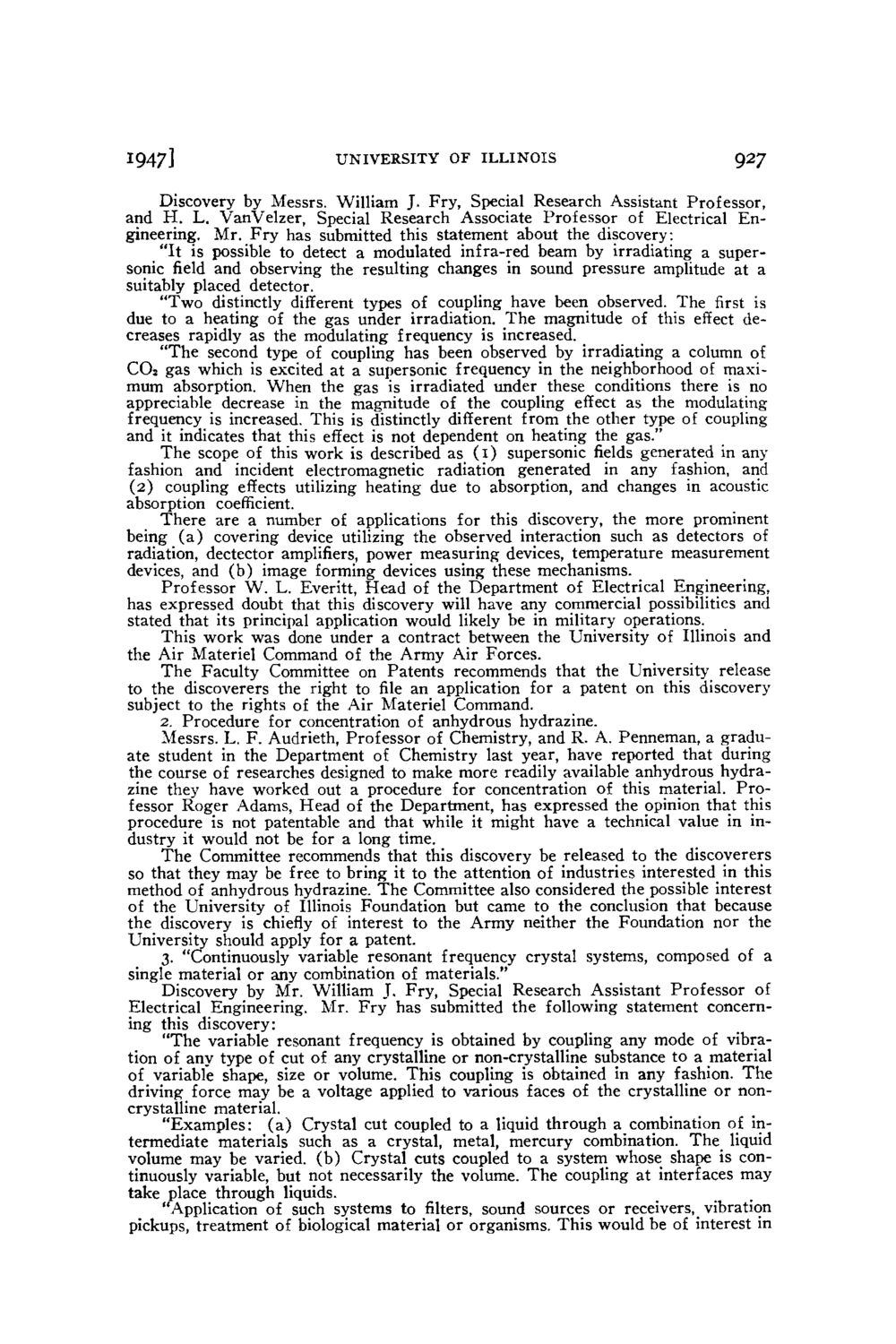| |
| |
Caption: Board of Trustees Minutes - 1948
This is a reduced-resolution page image for fast online browsing.

EXTRACTED TEXT FROM PAGE:
1947] UNIVERSITY OF ILLINOIS 927 Discovery by Messrs. William J. Fry, Special Research Assistant Professor, and H . L. VanVelzer, Special Research Associate Professor of Electrical Engineering. Mr. Fry has submitted this statement about the discovery: "It is possible to detect a modulated infra-red beam by irradiating a supersonic field and observing the resulting changes in sound pressure amplitude at a suitably placed detector. "Two distinctly different types of coupling have been observed. The first is due to a heating of the gas under irradiation. The magnitude of this effect decreases rapidly as the modulating frequency is increased. "The second type of coupling has been observed by irradiating a column of COs gas which is excited at a supersonic frequency in the neighborhood of maximum absorption. When the gas is irradiated under these conditions there is no appreciable decrease in the magnitude of the coupling effect as the modulating frequency is increased. This is distinctly different from the other type of coupling and it indicates that this effect is not dependent on heating the gas." The scope of this work is described as (1) supersonic fields generated in any fashion and incident electromagnetic radiation generated in any fashion, and (2) coupling effects utilizing heating due to absorption, and changes in acoustic absorption coefficient. There are a number of applications for this discovery, the more prominent being ( a ) covering device utilizing the observed interaction such as detectors of radiation, dectector amplifiers, power measuring devices, temperature measurement devices, and (b) image forming devices using these mechanisms. Professor W . L. Everitt, Head of the Department of Electrical Engineering, has expressed doubt that this discovery will have any commercial possibilities and stated that its principal application would likely be in military operations. This work was done under a contract between the University of Illinois and the Air Materiel Command of the Army Air Forces. T h e Faculty Committee on Patents recommends that the University release to the discoverers the right to file an application for a patent on this discovery subject to the rights of the Air Materiel Command. 2. Procedure for concentration of anhydrous hydrazine. Messrs. L. F . Audrieth, Professor of Chemistry, and R. A. Penneman, a graduate student in the Department of Chemistry last year, have reported that during the course of researches designed to make more readily available anhydrous hydrazine they have worked out a procedure for concentration of this material. P r o fessor Roger Adams, Head of the Department, has expressed the opinion that this procedure is not patentable and that while it might have a technical value in industry it would not be for a long time. The Committee recommends that this discovery be released to the discoverers so that they may be free to bring it to the attention of industries interested in this method of anhydrous hydrazine. The Committee also considered the possible interest of the University of Illinois Foundation but came to the conclusion that because the discovery is chiefly of interest to the Army neither the Foundation nor the University should apply for a patent. 3. "Continuously variable resonant frequency crystal systems, composed of a single material or any combination of materials." Discovery by Mr, William T. Fry, Special Research Assistant Professor of Electrical Engineering. Mr. Fry has submitted the following statement concerning this discovery: "The variable resonant frequency is obtained by coupling any mode of vibration of any type of cut of any crystalline or non-crystalline substance to a material of variable shape, size or volume. This coupling is obtained in any fashion. The driving force may be a voltage applied to various faces of the crystalline or noncrystalline material. "Examples: ( a ) Crystal cut coupled to a liquid through a combination of intermediate materials such as a crystal, metal, mercury combination. The liquid volume may be varied, (b) Crystal cuts coupled to a system whose shape is continuously variable, but not necessarily the volume. The coupling at interfaces may take place through liquids. "Application of such systems to filters, sound sources or receivers, vibration pickups, treatment of biological material or organisms. This would be of interest in
| |